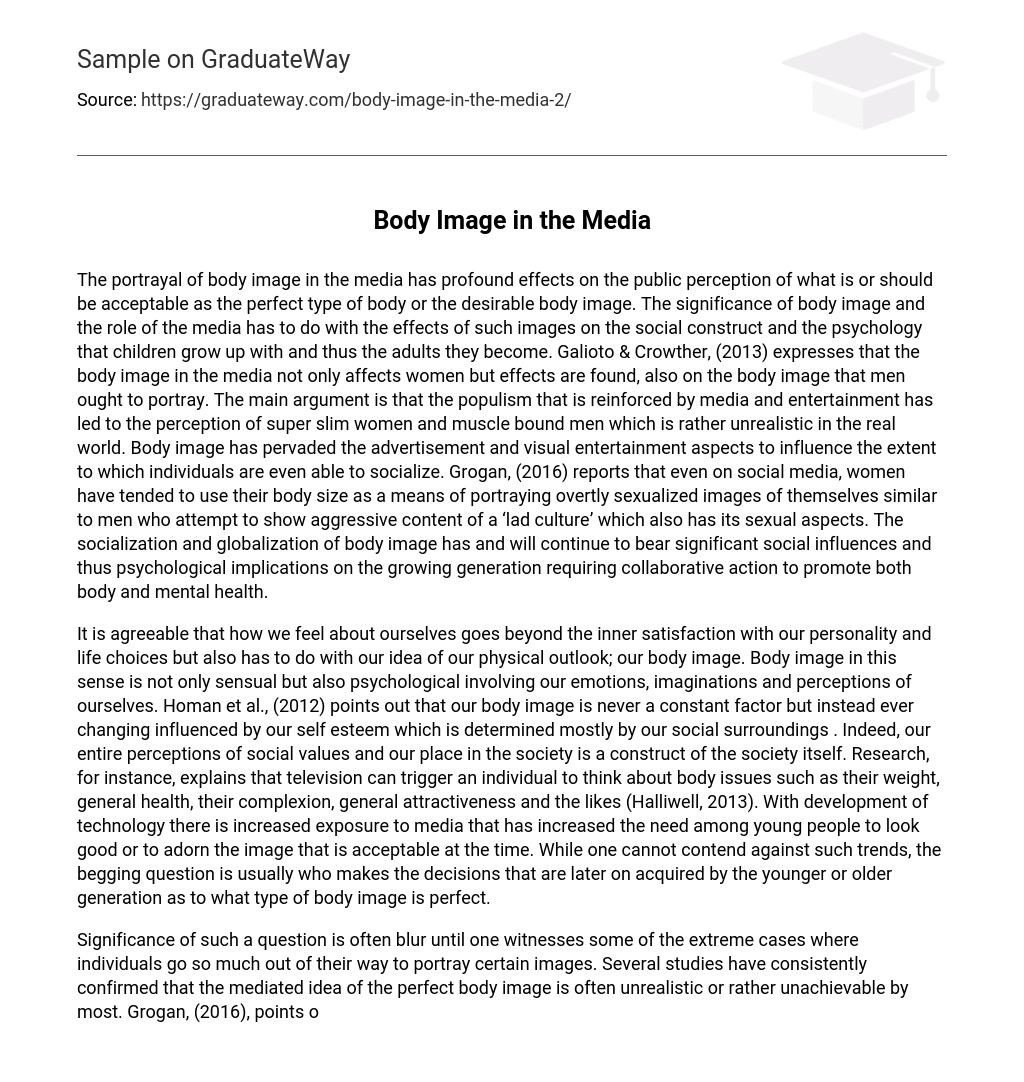The portrayal of body image in the media has profound effects on the public perception of what is or should be acceptable as the perfect type of body or the desirable body image. The significance of body image and the role of the media has to do with the effects of such images on the social construct and the psychology that children grow up with and thus the adults they become. Galioto & Crowther, (2013) expresses that the body image in the media not only affects women but effects are found, also on the body image that men ought to portray. The main argument is that the populism that is reinforced by media and entertainment has led to the perception of super slim women and muscle bound men which is rather unrealistic in the real world. Body image has pervaded the advertisement and visual entertainment aspects to influence the extent to which individuals are even able to socialize. Grogan, (2016) reports that even on social media, women have tended to use their body size as a means of portraying overtly sexualized images of themselves similar to men who attempt to show aggressive content of a ‘lad culture’ which also has its sexual aspects. The socialization and globalization of body image has and will continue to bear significant social influences and thus psychological implications on the growing generation requiring collaborative action to promote both body and mental health.
It is agreeable that how we feel about ourselves goes beyond the inner satisfaction with our personality and life choices but also has to do with our idea of our physical outlook; our body image. Body image in this sense is not only sensual but also psychological involving our emotions, imaginations and perceptions of ourselves. Homan et al., (2012) points out that our body image is never a constant factor but instead ever changing influenced by our self esteem which is determined mostly by our social surroundings . Indeed, our entire perceptions of social values and our place in the society is a construct of the society itself. Research, for instance, explains that television can trigger an individual to think about body issues such as their weight, general health, their complexion, general attractiveness and the likes (Halliwell, 2013). With development of technology there is increased exposure to media that has increased the need among young people to look good or to adorn the image that is acceptable at the time. While one cannot contend against such trends, the begging question is usually who makes the decisions that are later on acquired by the younger or older generation as to what type of body image is perfect.
Significance of such a question is often blur until one witnesses some of the extreme cases where individuals go so much out of their way to portray certain images. Several studies have consistently confirmed that the mediated idea of the perfect body image is often unrealistic or rather unachievable by most. Grogan, (2016), points out that body image is particularly vital during adolescent when the individual begins to gain consciousness of their body image. Essentially, at that age both boys and girls begin noticing each other and the need for social acceptance encompasses all the youth. There are concerns that the mediated idea of body image may have significant impacts on the ability of adolescents to fit in with others. Grogan, (2016), continues that the adolescent stage has profound influences on the future of the individual such that the body image perceptions that the individual acquires while young may emerge to be the same idea they have of themselves even as adults. Meanwhile, the media continues to influence the manner in which we perform most of our activities, including how we eat, how we speak to each other and also, importantly, how we perceive ourselves and our bodies.
In America today, it is rather a struggle to maintain an identity with the constantly changing socio-cultural environment due to a globalized society. The inability to capture who we really are as a society outplays as a dilemma among the youth. There are several vices that are attributed to media consumption that are simply trends that the public quickly picks up as the acceptable way of life. [citation] explains that at adolescent stage most of the youths do not really have a say what they want to be like but are rather led on by social media and peer groups. With such a slippery slope there is usually a great extent to which body image is influenced by the individual level of self esteem and how much they value their own decision over external perceptions or influences. The rationale is that apart from the need for social acceptance adolescents also usually need a sense of purpose in the sense of what they want to be and how they are to achieve the same. Accordingly, considering their age implications, adolescents remain susceptible to most influences that come their way and are easily persuaded into certain behaviors.





